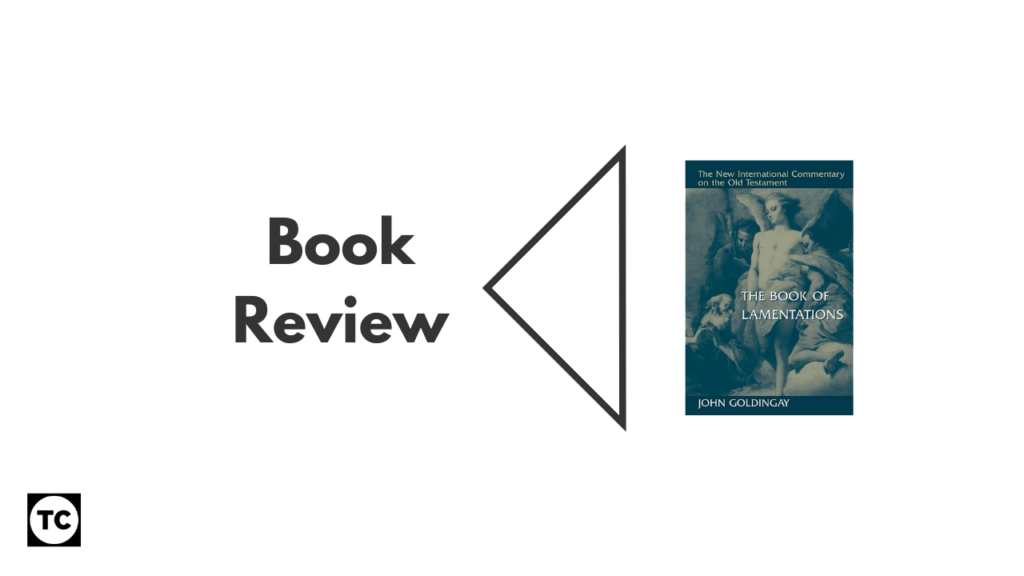Reviewing commentaries is a tricky business – particularly for me as a generalist, and an in-publisher editor of commentaries! I tend to offer my review based on the format and content of the volume, and it’s utility or otherwise to preachers and pastors. Occasionally I’ll digress into particularly theological or stylistic quirks.

The book of Lamentations is one that I think a lot of readers of the Bible are aware of, but not one that is particularly often preached, or studied devotionally. Certainly it isn’t one I’ve spent much time in. So this year I decided to work through three commentaries – though one of these I ended up reading separately from my devotional time. As well as the NICOT by Goldingay I’m reviewing today, I read Jonny Gibson’s entry in the ESV Expository Commentary, and Gina Hens-Piazza’s entry in the ‘Wisdom Commentary’. I normally appreciate NICOT volumes – recently reviewing Ashley on Numbers and Harrington on Ezra/Nehemiah – and am also a fan generally of John Goldingay, particularly appreciating his Baker commentary on Genesis. So it was somewhat disappointing to be underwhelmed by this volume.
In general, the volume follows the standard NICOT format, but a couple of changes threw me off and in my view distracted from it’s utility as a book. Firstly, rather than the normal practice of having the text first, Goldingay opts for a slightly odd mixture of walls of text and pages of bullet points. This reduces readability, which to be fair is not a core value of the commentary as a genre, but also looks messy on the page, and felt to me a bit like some first draft notes and exegesis – the content wasn’t bad, it just felt badly arranged to me. The second variation on the NICOT formula (which I don’t recall/didn’t notice being explained) was the addition of ‘A Reader’s Response’, at the end of each chapter, following the form of “Imagine someone who has taken part in reading Lam 1 at a worship gathering in Mizpah or Bethel” (p. 82). This does in fairness link to the historical usage of the book, but it felt a bit random in this kind of commentary, and so subjectively folk might find it more helpful than I do.
To move to the more positive aspects of this book – it was weak overall in my view, rather than bad – Goldingay offers some helpful background and context, for example noting that “In form, the poem overlaps with funeral laments and with city laments known from elsewhere in the ancient Near East” (p. 45). He notes – but in my view doesn’t pursue – some interesting canonical links, for example with reference to Job; “Lamentations is not simply working retrospectively; it has lots of concrete prophetic warnings to back up its assessment” (p. 58). Similarly, he notes that the pairing of chapters 1 and 2 compare “with pairings elsewhere in the Scriptures – such as the two (or more) accounts of creation, of God appearing to Moses, of Solomon’s prayer at the temple dedication, of the fall of Jerusalem, of the birth of Jesus, and of Jesus’s appearing to Paul” (p. 88). Given that this is a relatively short commentary, about a relatively short book of the Bible, I wondered why he didn’t explore some of these connections.
One of the core themes or issues in Lamentations is the relationship between suffering and spirituality. Goldinagay puts it well when he writes: “Lamentations is not just theory, and it is not concerned with theodicy – certainly not as a theoretical exercise – but neither is it just piety. As the poem melds theology and spirituality, it makes key theological statements about God. But part of its point in doing so is to lean on Yahweh to be himself” (p. 139). A key aspect of that melding is noted in the truth, picked up by Goldingay, that “the poem is talking about the fact that Yahweh sits enthroned over the universe. Yahweh is King” (p. 204). Goldingay’s concluding words (Before the aforementioned ‘A Reader’s Response’) are helpful: “Lamentations actualyl ends with protest and then with silence. Its appeal meets with no response from God within the book. Yet that observation is tautologous. Lam 5 is a prayer. Prayers as prayers do not incorporate responses. The prayers in the Psalms do not. It is because they are – well, prayers. Lam 5, with its more free-form structure has even been read as a hopeful, Sabbath-like ending to the scroll” (p. 209).
Overall, then this is a slightly infuriating commentary – Goldingay’s differentiation from the well established (And, as ever, in the phsyical printing, a beautiful book from Eerdmans) NICOT formula is in my view unhelpful, and makes it a little less readable. There is some really helpful exegesis, background and ‘commentary’ – I would have liked to have seen a little more joining up of themes and threads, and a fuller conclusion.
3/5
Leave a Reply